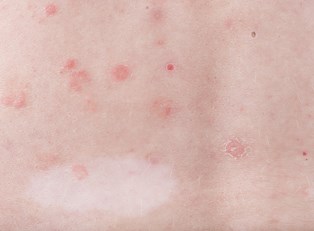Guttate psoriasis is a skin condition that causes small, red bumps called papules to form on the skin of the arms, back and torso. Although no cure for guttate psoriasis exists, a few effective treatments are available.
Guttate psoriasis is one of five specific types of psoriasis. Psoriatic skin conditions result from localized changes in the way dead skin cells are replaced. The skin of a person without psoriasis replaces old cells every 28 to 30 days; in a person with one or more forms of psoriasis, this process is accelerated, occurring as frequently as every three to four days.
In patients diagnosed with guttate psoriasis, this rapid production of new skin cells causes raised areas of red, inflamed skin. The word guttate is derived from a Latin word meaning “drop,” as guttate lesions look similar to small droplets on the skin. These lesions can be as small as 1 millimeter or as large as 1 centimeter.
Treatments
Most cases of guttate psoriasis will resolve without any treatment. However, spontaneous remission can take as long as six months, and some patients may go on to develop chronic versions of the condition that do not go away. Your dermatologist will recommend treatment if your case is severe, your rash is painful or very itchy, you are suffering from visible lesions that negatively affect your self-esteem, or if your rash is not improving on its own.
- Corticosteroids and Moisturizers
The most common treatment option is a corticosteroid cream such as hydrocortisone. A corticosteroid is a drug that’s very similar to steroid hormones found naturally in the human body. For psoriasis treatment, a steroid cream applied to affected areas can reduce inflammation and itching while inhibiting the rapid growth of skin cells that defines the condition.
If creams bought at a store do not work, your dermatologist can prescribe a much stronger version. Long-term use of topical steroids can have negative side effects, so always consult with your doctor. For mild cases, moisturizing cream can help alleviate itching and flaking. - Phototherapy
A second treatment is phototherapy, which involves exposure of the affected areas to ultraviolet light. Phototherapy greatly reduces recovery time from outbreaks of guttate psoriasis.
Phototherapy can be as simple as spending a few more hours in the sun each day. More resistant cases are treated directly with light produced by an artificial source, and this can be done in the dermatologist’s office or at home. Psoralen, a drug that increases the skin’s sensitivity to light, may be applied to the skin before phototherapy—this is called the PUVA treatment. Some dermatologists believe that UV-B light is safer and more effective than PUVA. Scheduling an appointment with a dermatologist specializing in psoriasis is necessary for deciding whether a certain type of phototherapy is right for you. - Vitamin D
Past clinical studies demonstrate that vitamin D supplements improve guttate psoriasis, though the exact way in which they do is unknown.



